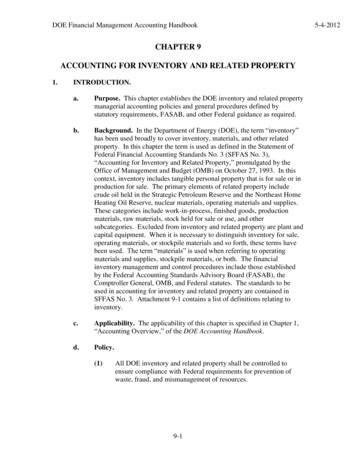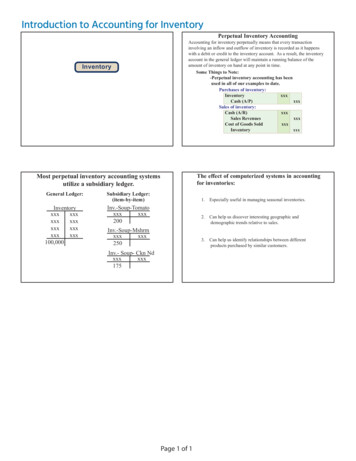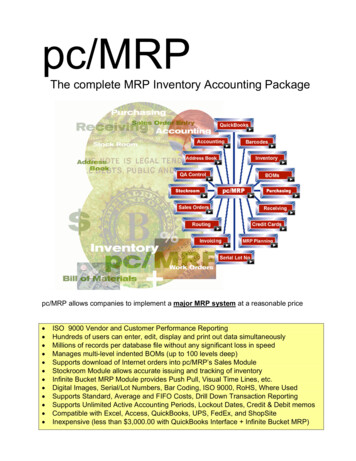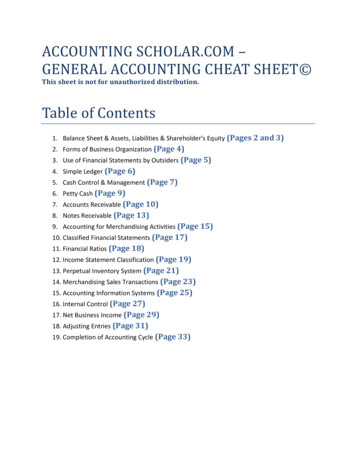
Transcription
DOE Financial Management Accounting HandbookCHAPTER 9ACCOUNTING FOR INVENTORY AND RELATED PROPERTY1.INTRODUCTION.a.Purpose. This chapter establishes the DOE inventory and related propertymanagerial accounting policies and general procedures defined bystatutory requirements, FASAB, and other Federal guidance as required.b.Background. In the Department of Energy (DOE), the term “inventory”has been used broadly to cover inventory, materials, and other relatedproperty. In this chapter the term is used as defined in the Statement ofFederal Financial Accounting Standards No. 3 (SFFAS No. 3),“Accounting for Inventory and Related Property,” promulgated by theOffice of Management and Budget (OMB) on October 27, 1993. In thiscontext, inventory includes tangible personal property that is for sale or inproduction for sale. The primary elements of related property includecrude oil held in the Strategic Petroleum Reserve and the Northeast HomeHeating Oil Reserve, nuclear materials, operating materials and supplies.These categories include work-in-process, finished goods, productionmaterials, raw materials, stock held for sale or use, and othersubcategories. Excluded from inventory and related property are plant andcapital equipment. When it is necessary to distinguish inventory for sale,operating materials, or stockpile materials and so forth, these terms havebeen used. The term “materials” is used when referring to operatingmaterials and supplies, stockpile materials, or both. The financialinventory management and control procedures include those establishedby the Federal Accounting Standards Advisory Board (FASAB), theComptroller General, OMB, and Federal statutes. The standards to beused in accounting for inventory and related property are contained inSFFAS No. 3. Attachment 9-1 contains a list of definitions relating toinventory.c.Applicability. The applicability of this chapter is specified in Chapter 1,“Accounting Overview,” of the DOE Accounting Handbook.d.Policy.(1)All DOE inventory and related property shall be controlled toensure compliance with Federal requirements for prevention ofwaste, fraud, and mismanagement of resources.9-15-4-2012
DOE Financial Management Accounting HandbookChapter 92.3.05-04-2012Accounting for Inventory and Related Property(2)Inventory and related property under financial control shall berecorded as assets in standard general ledger (SGL) accounts fromthe time of acquisition until issued for use, sold, consumed, ordisposed of in the normal course of operations.(3)Inventory and related property controls shall include completion ofphysical counts at prescribed intervals and, when appropriate,control by use of perpetual records. Physical counts and quantityrecords shall be reconciled and adjusting entries prepared to bringphysical and financial records into agreement. If products are toohazardous or inaccessible for a physical count, alternative means(such as perpetual records and measuring techniques) shall be usedto establish quantities.(4)Inventory and related property records (both quantity andfinancial) shall be controlled by reconciliation of subsidiary andcontrol accounts with the standard general ledger financial controlaccounts at least annually.(5)Records shall be maintained that disclose the reconciliation ofcosts and quantities. Inventory and related property shall bereconciled with the quantitative reports of the appropriate quantityaccountability system.REFERENCES.a.Department of Energy Property Management Regulations (DOEPMR), under Title 41, Chapter 109, of the Code of Federal Regulations(41 CFR 109).b.DOE Orders 410, 470, and 5660 Series, which provide for control,accountability and management of nuclear materials.c.Office of Management and Budget statement of Federal FinancialAccounting Standards Number 3, “Accounting for Inventory andRelated Property.”d.National Nuclear Security Administration (NNSA), ProductionAccounting Handbook.REVIEW AND IMPLEMENTATION OF PROCEDURES. Heads ofOrganizations shall be responsible for the following:9-2
DOE Financial Management Accounting HandbookChapter 94.05-04-2012Accounting for Inventory and Related Propertya.Reviewing inventory and related property procedures established by eachorganization under their cognizance to ensure that procedures provideadequate controls and are in accordance with prescribed policies;b.Reviewing and approving detailed procedures for the taking of physicalcounts and any authorized procedures permitting test-check verification;c.Maintaining a workable interface between quantity and financial recordsfor inventory or related property;d.For nuclear material processing and recovery, ensuring that facilitiesestablish salvage values consistent with these regulations for each type ofrecoverable nuclear material. These salvage values shall be usedconsistently to calculate net realizable values for salvageable materials tobe recorded in financial systems. When changed economic conditionsrequire a change in the established salvage values, the new values will beprovided to those offices that need the information for use in decisionmaking;e.Encouraging the use of performance measures to assist in the managementof inventory and related property;f.Requiring that sub-tier organizations (subcontractors, etc.) report to DOEor its major site/facility operating contractors on the status of DOE-ownedinventory and related property held by the sub-tier organizations.ACCOUNTING FOR INVENTORY AND MATERIALS.a.Acquisition. Generally, inventory or materials acquired shall be recordedat the actual cost of acquisition, which includes the net purchase price(gross billing less discounts) plus packing, transportation, docking, andrelated charges required to place the inventory or material in storage readyfor issue. Nuclear materials produced are recorded at the actual cost ofproduction. Inventory or materials transferred will be recorded at actualcost, or standard transfer value (STV) when an STV has been established.Oil produced from the Naval Petroleum Reserve (NPR) qualifies under avaluation exception in SFFAS No. 3 and is carried at expected netrealizable value.b.Inventory and Materials Valuation. Inventory and materials shall bevalued at historical cost. Historical cost includes all appropriate purchaseand production costs incurred to bring an item to its current condition andlocation. The cost flow assumptions used will be moving average,weighted average, or first-in, first-out (FIFO). Moving average is acosting method under which an average unit cost is computed after each9-3
DOE Financial Management Accounting HandbookChapter 905-04-2012Accounting for Inventory and Related Propertyacquisition. Weighted average is a costing method under which anaverage unit cost is computed periodically. It is acceptable to valueinventory for sale at expected net realizable value if three criteria are met:(1) there is an inability to determine approximate cost; (2) the items haveimmediate marketability at quoted prices; and (3) there is unitinterchangeability of the items. Perpetual records will reflect these costflow assumptions. Valuation methods are shown in Attachment 9-2.c.Operating Materials and Supplies. Operating materials and suppliesconsist of tangible personal property to be consumed in normal operationsand should be valued using the consumption method. However, thepurchases method allows operating materials and supplies to be expensedwhen purchased. The purchases method of valuation may be used if (1)the operating materials and supplies are not significant dollar amounts; (2)they are in the hands of the end user for use in normal operations; or (3) itis not beneficial to apply the consumption method of accounting.d.Goods Manufactured or Produced in DOE Facilities.e.(1)The cost of items manufactured or produced includes applicabledirect and indirect costs, including depreciation, that are incurredin converting or fabricating inventory or materials into usableforms. Costs that relate to selling and administration are notinventory or related material costs. Applicable Cost AccountingStandards (CAS) and FASAB SFFAS No. 4, “Managerial CostAccounting Concepts and Standards,” provisions will be followedin accumulating and allocating costs to products produced ormanufactured.(2)Usable byproducts should be assigned some cost. If actual costcannot be determined, a portion of the total cost of the productsproduced may be assigned to the byproducts based on a recognizedaccounting practice such as relative market values. If marketvalues cannot be determined, realistic market value estimates orengineering cost estimates may be used. The methods used forarriving at cost must be in accordance with CAS, or SFFAS No. 4,as supported by Generally Accepted Accounting Principles(GAAP).Return of Previously Issued Items to Stock.(1)New Items. Items previously issued from stock that are returnedto stock in new condition shall be valued at the current unit cost forlike items at the time of return.9-4
DOE Financial Management Accounting HandbookChapter 905-04-2012Accounting for Inventory and Related Property(2)Used Items. For items returned to stock in used condition, if thereturned items can be used without being reworked, the returneditems shall be valued at their fair value at the time of return. Ifthey are reworked, value them as new items and expense anyexcess rework cost. The Power Marketing Administrations shallfollow procedures provided by Federal Energy RegulatoryCommission guidelines in Title 18, Chapter 1, Subchapter C, Part101, of the Code of Federal Regulations for reusable material inutility operations.f.Cost Recognition. Inventory or materials to be expended (costed) will beremoved from the capital account at the carrying value (book value) of theitem. Losses should be recognized on the accounting records as soon asthey are known or estimable. At the time that title passes to a purchaser,the goods are delivered to the purchaser, or the goods are used in theprovision of a service, the related expense shall be recognized and the costof the goods shall be removed from the inventory or materials account.Expense recognition is also necessary when there is no future benefit to bederived by the entity from an asset. As inventory or material is sold, thecost must be charged to the cost of goods sold in order to achieve amatching of cost and revenue. Inventory or material is to be reported asan operating expense in the period in which it is issued to an end-user forconsumption in normal operations.g.Inventory or Material Gains/Losses. Gains (when the actual count ofthe number of items in stock is greater than the number of items shown onthe perpetual records) shall be valued at the unit value shown on theinventory records at the time the gain is recognized. Losses (when thecount is less than shown on the records) will be expended at the valueshown on the inventory records at the time the loss is recognized.h.Donations. Inventory donations received shall be capitalized, but whenthe item donated requires reworking, it will be valued at the current unitvalue of like items in stock less the cost of reworking the item. If likeitems are not in stock, the donation will be valued at the estimated netrealizable value to approximate “fair value” required by SFFAS No. 3i.Repairs. SFFAS No. 3 specifies how inventory held for repair may betreated. DOE has provided account codes for use of the direct method.Under the direct method, inventory held for repair shall be valued at thesame value as a serviceable item less the estimated repair costs. To avoidoverstating repair expenses for the first period that the repair expenses areaccrued, prior-period repair expenses are to be separately identified orestimated. The estimated amount applicable to prior periods shall becredited to the inventory account and reported as an adjustment to equity.9-5
DOE Financial Management Accounting HandbookChapter 905-04-2012Accounting for Inventory and Related PropertyWhen the repair is actually made, the cost of the repair shall be capitalizedin the inventory account up to the value of a serviceable item. Anydifference between the initial estimated repair costs shall either be debitedor credited to the repair expense account. The provisions of this statementneed not be applied to immaterial items.5.INVENTORY AND RELATED PROPERTY COSTS. Inventory and relatedproperty costs shall be classified in accordance with appropriate FederalStandards, CAS, and GAAP requirements. Costs are often classified as productcosts or period costs. Product costs are capitalized into the inventory or productaccount while period costs are expensed and should be considered in pricingproducts. Inventory and material costs will include costs that are incurred toacquire the inventory or material and bring it to the initial desired status andlocation.a.Manufacturing and Production Costs. All manufacturing andproduction costs, direct and indirect, are product costs. These includemanufacturing material and labor, factory rent, factory machinerydepreciation, factory taxes, and factory insurance; that is, costs thatdirectly benefit the product. Product costs include (1) direct material, (2)direct labor, and (3) indirect manufacturing costs. Indirect manufacturingcosts include manufacturing or production facility costs for the items listedbelow. If more than one product or cost center is benefited, aproportionate share of the expense should be allocated to each benefitingproduct or cost center.(1)Indirect Manufacturing (Production) Costs.(a)Indirect material or factory supplies, such as grease, oil,cleaning supplies, polishing compounds, and factory officesupplies;(b)Indirect labor, such as foremen, inspectors, watchmen,supervisors, clerks, janitors, elevator operators,storekeepers, and timekeepers;(c)Building occupancy costs, such as rent, taxes, insurance,depreciation, heat, light, and maintenance;(d)Depreciation of machinery and factory equipment (whendepreciation relates to selling or administration functions, itis not inventoried);(e)Cost of small tools used in factory departments;9-6
DOE Financial Management Accounting HandbookChapter 905-04-2012Accounting for Inventory and Related Property(f)Power;(g)Federal Insurance Contribution Act (FICA) taxes onfactory payrolls;(h)Payroll fringe benefits, such as holiday pay, insurance, andpension fund payments; and(i)Workers’ compensation insurance premiums (wheninsurance relates to selling or administration functions, it isnot included).(2)Selling Expenses. Selling expenses are period costs. They are notallocated to inventory or material capitalized cost. Sellingexpenses are usually not known until after the product is sold.Selling expenses would include insurance and depreciation relatingto the sales operation.(3)Warehousing or Storage Expenses. Warehousing or storageexpenses are period costs. They typically occur after the inventoryor material is received. These expenses are computed or estimatedwhen determining holding cost.(4)Administrative Expenses. Administrative expenses are periodcosts. They cover a wide range of indirect activities not directlyrelated to factory or production activities. They includedepreciation on central administration building and officeequipment and clerical salaries for site administration.(5)Other Period Costs. Other period costs include casualty and theftlosses, research and experimental cost, and engineering and designcost.(6)Optional Costs. Some costs may be treated as period costs orproduct costs, but they must be treated consistently. These are (1)employee benefits for factory or production direct and indirectlabor (for current service); (2) rework labor, scrap, and spoilage;and (3) factory or production administration.(7)Government Mission Costs. Some government mission costs arealways period costs. These are costs incurred in carrying outgovernment missions that are not related to the administration,manufacturing, or production of the product. These costs includesocial program costs, security costs related to government missionsand not related to production or production administration, security9-7
DOE Financial Management Accounting HandbookChapter 905-04-2012Accounting for Inventory and Related Propertycosts in excess of normal industrial security, and inspections andquality reviews for governmental (as opposed to production orproduction administration) purposes.b.Strategic Petroleum Reserve (SPR) Material Costs. For SPR missionactivities, terminology differs, but the basic principles and activitiesremain the same. In terms of SPR activities, the following applies:(1)Crude Oil Material Cost. Production costs include (1) directmaterial, (2) direct labor, and (3) indirect costs of transportationand terminal costs. To be a product cost, the cost must be a primecost (direct material and direct labor) or specifically related tomoving the stockpile material into the initial location (cavern) forstorage. Costs that relate to selling or administration are notproduct costs. Costs that relate to movement of crude oil productfrom location to location, after initial positioning, and costs toposition product for sale are not product costs; they are selling andinefficiency costs.(2)Indirect Transportation and Terminal Costs. These are costsincurred in getting the product to its initial desired status instorage. They include the following:(a)Terminal materials or supplies such as grease, oil, cleaningsupplies, chemicals, and terminating office supplies;(b)Terminal labor such as foremen, inspectors, workmen,supervisors, clerks, janitors, elevator operators,storekeepers, timekeepers, and product testers;(c)Terminal building occupancy costs such as rents, taxes,insurance, depreciation, heat, electricity, and maintenance;(d)Depreciation of machinery, pipelines, vessels, and otherterminal equipment;(e)Cost of small tools used in terminal departments;(f)FICA taxes on terminal payrolls;(g)Terminal payroll fringe benefits, such as holiday pay,insurance, and pension fund payments;(h)Terminal workers’ compensation insurance premiums;9-8
DOE Financial Management Accounting HandbookChapter 905-04-2012Accounting for Inventory and Related Property(3)(4)(i)Transportation to port-of-entry or SPR docking facility;(j)Charges, including lab tests, for inspection of productdelivered to determine quality, quantity, and acceptability;(k)Charges for delivery vessel docking, mooring, unmooring,and unloading of product;(l)Pipeline usage charges for initial acquisition of product;(m)Costs for landing of cargo, including temporary bargedemurrage, cleaning, repairs, and rental; and(n)Custom fees and Superfund taxes for product.Nonproduct Costs or Period Costs. Costs, such as advertisingand sales salaries, that are generally not related to production andare not attached to the product (such as material and labor costs)are considered period costs. The following period costs are notallocated to inventory or materials:(a)General and administrative expenses;(b)Design, research, and experimental costs;(c)Casualty and theft losses;(d)Distribution, handling, and warehousing charges; and(e)Marketing, advertising, and selling expenses.Optional Costs. Some costs are optional costs and may be treatedeither as product or period costs; however, they must be treatedconsistently. That is, once a method of treatment is selected, it is apermanent decision. Optional costs are:(a)Employee benefits for current services;(b)Rework labor, scrap, and spoilage; and(c)Administration performed for inventory or materialproduction, moving, and location activities.9-9
DOE Financial Management Accounting HandbookChapter 96.05-04-2012Accounting for Inventory and Related PropertyINVENTORY AND RELATED PROPERTY CONTROL GUIDELINES.a. Data Requirements. Perpetual records shall be maintained for all DOEowned inventory and materials under financial control. SGL accountingcodes are esta
operating materials, or stockpile materials and so forth, these terms have been used. The term “materials” is used when referring to operating materials and supplies, stockpile materials, or both. The financial inventory management and control procedures include those established by the











